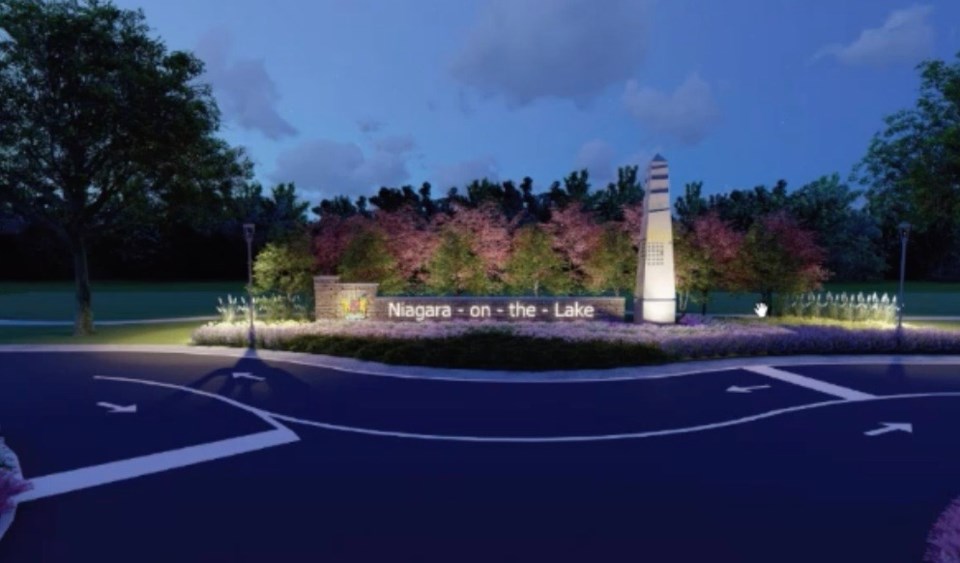
Gerry Kowalchuk and the town’s Communities in Bloom committee have taken a huge step forward toward creating a gateway to the Old Town designed to leave a lasting impression on all who see it.
It’s a project he began working on about two years ago, hoping to gain town support for rejuvenating the sign and flower beds at the end of Mississagua Street. After the Communities in Bloom committee gave him the go-ahead and formed a subcommittee, a landscape architecture firm was chosen, and work began in earnest on a design for the project.
The subcommittee, which includes two town councillors, along with Kevin Turcotte, the town’s manager of parks and recreation, and J.B. Hopkins, parks supervisor, working with the Sefarian Design Group from Toronto and senior landscape architect Brad Smith, whittled eight conceptual drawings down to one final design for the gateway. And recently received unanimous approval of their conceptual drawing from the town’s Communities in Bloom committee.
The next step is support from the town’s Municipal Heritage Committee, expected later this month, and then approval from council in July.
The town has recently been discussing a redesign of that intersection to control and slow down traffic, hopefully also redirecting vehicles away from Niagara Boulevard and the Chautauqua neighbourhood, says Kowalchuk. It would include a bump-out at the intersection, with a three-way stop, and the elimination of the left-turn lane.
The final conceptual design chosen by the gateway project’s working group includes the extra landscaping area the bump-out would provide, but could also work without it if the town decides not to go ahead with their plan for the intersection, he says.

In addition to a stone wall, one of the features is an obelisk structure that will symbolize the original lighthouse that was on the spot where Fort Mississauga now stands, says Kowalchuk. Hopkins discovered a lighthouse stood on that site in the early 1800s, before the fort was built, and although the gateway structure isn’t intended to replicate the lighthouse, it represents a symbol of what was there, he says.
In presenting the preferred concept to the Communities in Bloom committee, Smith explained the chosen design would incorporate a symbolic, eye-catching representation of NOTL, with beautiful gardens and stonework. It would offer a horizontal approach with a low, 40-foot Queenston Quarry limestone wall, the town crest and town name incorporated in it, with an obelisk structure of granite, about 25 feet tall, representing the first lighthouse on the Great Lakes. It would be easily seen coming into town, creating a striking first impression, and would include a strong, intricate lighting plan to make sure it’s just as striking at night, said Smith.
The sign that now advertises events in town, just off to the side of the existing gateway, will be relocated, says Turcotte. “That sign would detract from the feature we’re trying to create, so we felt it might be better living somewhere else.”
The bump-out and three-way stop, he says, would allow people to stop, enjoy the feature that is being created, and also pick up the sign that directs them to turn left to the QEW. The redesign of the intersection was suggested by the Friends of Ryerson Park, to alleviate some of the congestion they see during the tourist season in the Chautauqua area and on its narrow streets.
The whole area of the bump-out becomes part of the gateway feature, which would also include some plantings and beautification on the two corners on the other side of the road, and could create “a smaller plaza space” to allow for those who want to stop and photograph the new gateway, explained Smith.
Kowalchuk, who moved to NOTL a little more than a decade ago, wanted to undertake a project that would reflect the love he and his wife have for their new home. He says he is grateful for how his life has unfolded, and as a way of paying forward to help others, in 2014, he set up a family fund with the Niagara Community Foundation.The fund, which he manages with one of his daughters, was created to help people in need achieve their goals, but Kowalchuk says he began some time ago to think about a donation he could bequeath to the town, and decided he’d like to see it happen while he’s still alive, and can be involved in the project.
His first step, in the fall of 2019, was to ask Lord Mayor Betty Disero to stop by for a chat at his Rye Street home, where he briefly outlined his idea for a rejuvenation of the existing entrance to the Old Town, making it clear he was offering $250,000 to fund the project.
Disero set up a meeting with some town staff, and the project moved forward, following a suggestion that Kowalchuk make a presentation to the town’s Communities in Bloom committee, which he did, in December of 2019.
In January, 2020, councillors agreed with a CIB committee recommendation in favour of the project, to be financed by the Gerald Kowalchuk Family Fund. They also approved the formation of the Queen/Mississagua Project, the CIB subcommittee, to create terms of reference and a work plan for the site, which led to the hiring of a landscaping company and work on a conceptual design.
The drawings that were presented and approved by the Communities in Bloom committee, Kowalchuk stresses, are conceptual, not finalized, working drawings that would show details, such as the kinds of plantings.
He also wanted to stress that he has “high aspirations” for the project that would provide a gateway to the community, with landscaping excellence, and something to be proud of for generations to come.
The tentative timeline set out for construction was originally to begin in September, with a second phase to include planting next spring, and completion by June, in time for the next influx of tourists. With delays because of COVID and a desire “to get this right,” that has been changed, with construction to be tendered in the new year, work commencing as soon as possible after that, and planting in the spring, with completion targeted for June.